WHO’LL SAVE THE PLOW HORSE?
War Horse is almost critic-proof. It has been garnering all sorts of Best Play awards, but, in truth, there are all sorts of new, unrecognized categories for which War Horse can compete and still come out a winner. Let’s mention a few, why don’t we?
The Most Imaginative Use of Puppetry on an Epic Scale.
The Most Thrilling Visual Spectacle Ever Encountered in the Commercial Theater.
The Most Visceral and Harrowing Depiction of the Madness of War Ever Put on a Stage.
The Noblest Portrait of an Animal In All Its Grandeur in Theatrical History.
The Most Astonishing Proof That Cirque de Soleil Doesn’t Have the Patent on Spectacle Because At Last There is an Evening of Theater That Doesn’t Rely on Spectacle Alone.
I am certain that you get the idea.
Shall we take them now, one by one?
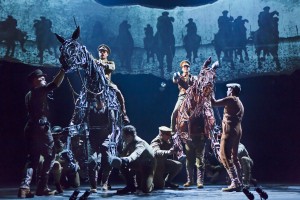 The Most Imaginative Use of Puppetry on an Epic Scale: There is no hiding the fact that the animals are marvels of stagecraft and are in no way intended to be mistaken for the real thing, but, since this is theater, the real thing would never seem nearly as human, because, after all, they are manipulated, in full sight, by humans, and gorgeously and triumphantly so, I must add. It would be easy to focus your attention on its two central horses, Topthorn and especially Joey, the horse that gives the play its title, but there is a wholly engaging goose and a couple of nasty vultures circling the air in the midst of death. But it is Joey who most captures our eyes, because he is so beautiful in his awkwardness as a foal and in his majesty as a full-grown stallion, and because, more than capture our eyes, he captures our hearts. When he is forced to become a plow horse, we really feel the labor it takes for him to move forward. Our hearts stop. Our compassion becomes, in an instant, an unbearable thing. He shies. He feints. He jumps. He leaps. He breathes. And the puppeteers clearly take full pleasure in putting him through his every single move. Adrian Kohler and Basil Jones and Handspring Puppet Company, who created the animals, and Toby Sedgwick, who choreographed the movement, should accept this particular honor with great pride and joy.
The Most Imaginative Use of Puppetry on an Epic Scale: There is no hiding the fact that the animals are marvels of stagecraft and are in no way intended to be mistaken for the real thing, but, since this is theater, the real thing would never seem nearly as human, because, after all, they are manipulated, in full sight, by humans, and gorgeously and triumphantly so, I must add. It would be easy to focus your attention on its two central horses, Topthorn and especially Joey, the horse that gives the play its title, but there is a wholly engaging goose and a couple of nasty vultures circling the air in the midst of death. But it is Joey who most captures our eyes, because he is so beautiful in his awkwardness as a foal and in his majesty as a full-grown stallion, and because, more than capture our eyes, he captures our hearts. When he is forced to become a plow horse, we really feel the labor it takes for him to move forward. Our hearts stop. Our compassion becomes, in an instant, an unbearable thing. He shies. He feints. He jumps. He leaps. He breathes. And the puppeteers clearly take full pleasure in putting him through his every single move. Adrian Kohler and Basil Jones and Handspring Puppet Company, who created the animals, and Toby Sedgwick, who choreographed the movement, should accept this particular honor with great pride and joy.
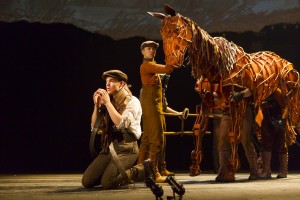 The Most Thrilling Visual Spectacle Ever Encountered in the Commercial Theater: The magnificence of the puppets is unquestioned, but it is in the magic created by its design team that transforms a clever conceit into truly thrilling theater. Through the simplest and yet most intensely imaginative means, towns and countries and landscapes and farms seem to be painted as we watch, appearing and vanishing and transforming themselves incandescently. Bombs burst in the air. Horses crash into rows of barbed wire. We are shot at and blinded and shaken. The theater becomes the fulcrum of the entire world that exists for us during three long and exhausting hours. Rae Smith, who created the sets and the splendidly etched drawings, and Paule Constable and Karen Spahn, who designed the amazing lighting effects which practically blow us out of our seats, and 59 Productions, which is responsible for the animation and projections, should accept this particular honor with equally great pride and joy.
The Most Thrilling Visual Spectacle Ever Encountered in the Commercial Theater: The magnificence of the puppets is unquestioned, but it is in the magic created by its design team that transforms a clever conceit into truly thrilling theater. Through the simplest and yet most intensely imaginative means, towns and countries and landscapes and farms seem to be painted as we watch, appearing and vanishing and transforming themselves incandescently. Bombs burst in the air. Horses crash into rows of barbed wire. We are shot at and blinded and shaken. The theater becomes the fulcrum of the entire world that exists for us during three long and exhausting hours. Rae Smith, who created the sets and the splendidly etched drawings, and Paule Constable and Karen Spahn, who designed the amazing lighting effects which practically blow us out of our seats, and 59 Productions, which is responsible for the animation and projections, should accept this particular honor with equally great pride and joy.
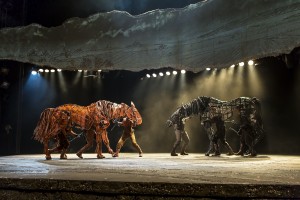 The Most Visceral and Harrowing Depiction of the Madness of War Ever Put on a Stage: Although War Horse starts out as a tender tale of a boy and his horse, its great power lies in its willingness to put on stage what, in the past, has been left to off-stage battle sounds in anti-war dramas, and which, in truth, has been largely left to the movies to explore: the terrible horrors of trench warfare in World War I, horrors that have echoed through the years, horrors that should have prevented the world from ever engaging in war again, horrors the world clearly learned nothing from. Who would have ever thought that such monstrous destruction could ever be shown on a stage? All of this literally explodes before us and has us rattling in our seats, scared to death and, at the same time, mesmerized. Who should accept this honor? Since, in effect, this is where War Horse really lives, the honor should go to Michael Morpurgo, who wrote the novel on which it is based, and to Nick Stafford, who, in his adaptation, painstakingly brought it to vivid life.
The Most Visceral and Harrowing Depiction of the Madness of War Ever Put on a Stage: Although War Horse starts out as a tender tale of a boy and his horse, its great power lies in its willingness to put on stage what, in the past, has been left to off-stage battle sounds in anti-war dramas, and which, in truth, has been largely left to the movies to explore: the terrible horrors of trench warfare in World War I, horrors that have echoed through the years, horrors that should have prevented the world from ever engaging in war again, horrors the world clearly learned nothing from. Who would have ever thought that such monstrous destruction could ever be shown on a stage? All of this literally explodes before us and has us rattling in our seats, scared to death and, at the same time, mesmerized. Who should accept this honor? Since, in effect, this is where War Horse really lives, the honor should go to Michael Morpurgo, who wrote the novel on which it is based, and to Nick Stafford, who, in his adaptation, painstakingly brought it to vivid life.
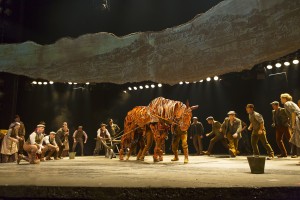 The Noblest Portrait of an Animal In All Its Grandeur in Theatrical History: This may be a trifle redundant, but, and it can’t be repeated often enough, Joey will live forever in the memory of anyone who sees War Horse, and his puppet masters – Christopher Mai, Derek Stratton, Rob Laqui, Laurabeth Breya, Catherine Gowl, Nick Lamedica (at the performance I attended) – should receive this honor, again with great pride and joy. They made Joey dance. You may find your own word to describe the way Joey moves not only on stage but in the way he moves into our lives. Joey has dignity and aristocratic mien and, even when bloodied and close to dying, he has in him the juices of a life lived harshly but purposefully. Great horse!
The Noblest Portrait of an Animal In All Its Grandeur in Theatrical History: This may be a trifle redundant, but, and it can’t be repeated often enough, Joey will live forever in the memory of anyone who sees War Horse, and his puppet masters – Christopher Mai, Derek Stratton, Rob Laqui, Laurabeth Breya, Catherine Gowl, Nick Lamedica (at the performance I attended) – should receive this honor, again with great pride and joy. They made Joey dance. You may find your own word to describe the way Joey moves not only on stage but in the way he moves into our lives. Joey has dignity and aristocratic mien and, even when bloodied and close to dying, he has in him the juices of a life lived harshly but purposefully. Great horse!
The Most Astonishing Proof That Cirque de Soleil Doesn’t Have the Patent on Spectacle etc: All of this happens not for the sheer spectacle of it all – which might very well have been enough – but because its spectacle is contained within a love story that is universal in its appeal. This is the triumph of War Horse.
But…..
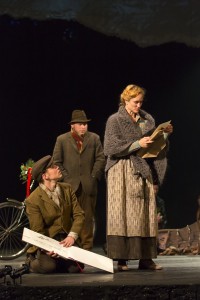 Best Play? Well, it tells a story, telling it from line to line, more interested in furthering its plot than in revealing character, and it moves swiftly enough, and, despite the absence of nuance or subtlety, it keeps the audience more or less engaged. It may strut its stuff starkly and powerfully, but it is definitely more interested in the effect it will have on us as spectators than it is in moving us. We marvel at its theatricality and are stirred, from time to time, but it does seem more like a well-oiled machine than a throbbing drama. The boy, Albert, is played with disarming sincerity by Andrew Veenstra, and his scenes with Joey exude a natural and quiet charm, but most of the performances are pitched at a broad and posturing level, as if many of the characters might suddenly burst into song. It is a guess, merely a guess, that the standardized British accents of the cast are no match for what must have been the effortless Devon accents of its cast in the original National Theatre of Great Britain production and its subsequent Lincoln Center production. More effortlessness might have created the illusion of familial verisimilitude that this production has in short supply. It doesn’t really grapple with the complexities of the human condition as a play, in the accepted sense, might have done. It might be blasphemous of me to say so, but the Steven Spielberg film had more heart. I mean, after all, War Horse doesn’t even lay a claim to sophistication, except on a technical level: this is children’s theater. High class children’s theater, to be sure, and you’d be foolish to keep the children at home when you see it, but it is children’s theater just the same. There’s nothing intrinsically wrong with that. We could use more and better children’s theater. But it is as spectacle that the real beauty of War Horse stands most proudly.
Best Play? Well, it tells a story, telling it from line to line, more interested in furthering its plot than in revealing character, and it moves swiftly enough, and, despite the absence of nuance or subtlety, it keeps the audience more or less engaged. It may strut its stuff starkly and powerfully, but it is definitely more interested in the effect it will have on us as spectators than it is in moving us. We marvel at its theatricality and are stirred, from time to time, but it does seem more like a well-oiled machine than a throbbing drama. The boy, Albert, is played with disarming sincerity by Andrew Veenstra, and his scenes with Joey exude a natural and quiet charm, but most of the performances are pitched at a broad and posturing level, as if many of the characters might suddenly burst into song. It is a guess, merely a guess, that the standardized British accents of the cast are no match for what must have been the effortless Devon accents of its cast in the original National Theatre of Great Britain production and its subsequent Lincoln Center production. More effortlessness might have created the illusion of familial verisimilitude that this production has in short supply. It doesn’t really grapple with the complexities of the human condition as a play, in the accepted sense, might have done. It might be blasphemous of me to say so, but the Steven Spielberg film had more heart. I mean, after all, War Horse doesn’t even lay a claim to sophistication, except on a technical level: this is children’s theater. High class children’s theater, to be sure, and you’d be foolish to keep the children at home when you see it, but it is children’s theater just the same. There’s nothing intrinsically wrong with that. We could use more and better children’s theater. But it is as spectacle that the real beauty of War Horse stands most proudly.
photos by Brinkhoff/Mögenburg
War Horse
Ahmanson Theatre in Los Angeles
scheduled to end on July 29, 2012
for tickets, call 213.680.4017 or visit http://CenterTheatreGroup.org
then continuing on its US National Tour
scheduled to end on June 30, 2013
for cities, dates, and tickets, go to http://warhorseonstage.com/tickets/us_tour
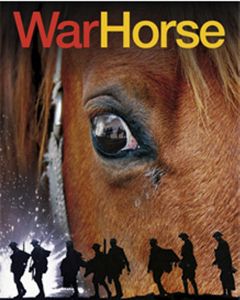

{ 1 comment… read it below or add one }
You did it again. Excellent review. Great Children’s Theater. Wonderful puppetry. Boy meets horse etc….